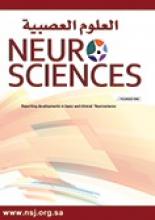Research ArticleOriginal Article
Open Access
Predicting future handedness and hemispheric dominance during infancy by analyzing sleep spindles
Ali H. Alwadei, Turki F. AlOsaimi, Manar A. Bayounis, Ghadd A AlHajaj and Fahad A. Bashiri
Neurosciences Journal July 2020, 25 (3) 188-192; DOI: https://doi.org/10.17712/nsj.2020.3.20190129
Ali H. Alwadei
From the Pediatric Neurology Department (Alwadei, AlOsaimi), National Neuroscience Institute, King Fahad Medical City, Department of Pediatrics (Bayounis), Al-Yamama Hospital, Division of Pediatric Neurology (Bashiri), Department of Pediatrics, College of Medicine, King Khalid University Hospital, King Saud University and from the Department of Pediatrics (AlHajaj), Unaizah College of Medicine and Medical Sciences, Qassim University, Unaizah, Qassim, Kingdom of Saudi Arabia
MDTurki F. AlOsaimi
From the Pediatric Neurology Department (Alwadei, AlOsaimi), National Neuroscience Institute, King Fahad Medical City, Department of Pediatrics (Bayounis), Al-Yamama Hospital, Division of Pediatric Neurology (Bashiri), Department of Pediatrics, College of Medicine, King Khalid University Hospital, King Saud University and from the Department of Pediatrics (AlHajaj), Unaizah College of Medicine and Medical Sciences, Qassim University, Unaizah, Qassim, Kingdom of Saudi Arabia
MDManar A. Bayounis
From the Pediatric Neurology Department (Alwadei, AlOsaimi), National Neuroscience Institute, King Fahad Medical City, Department of Pediatrics (Bayounis), Al-Yamama Hospital, Division of Pediatric Neurology (Bashiri), Department of Pediatrics, College of Medicine, King Khalid University Hospital, King Saud University and from the Department of Pediatrics (AlHajaj), Unaizah College of Medicine and Medical Sciences, Qassim University, Unaizah, Qassim, Kingdom of Saudi Arabia
MDGhadd A AlHajaj
From the Pediatric Neurology Department (Alwadei, AlOsaimi), National Neuroscience Institute, King Fahad Medical City, Department of Pediatrics (Bayounis), Al-Yamama Hospital, Division of Pediatric Neurology (Bashiri), Department of Pediatrics, College of Medicine, King Khalid University Hospital, King Saud University and from the Department of Pediatrics (AlHajaj), Unaizah College of Medicine and Medical Sciences, Qassim University, Unaizah, Qassim, Kingdom of Saudi Arabia
MDFahad A. Bashiri
From the Pediatric Neurology Department (Alwadei, AlOsaimi), National Neuroscience Institute, King Fahad Medical City, Department of Pediatrics (Bayounis), Al-Yamama Hospital, Division of Pediatric Neurology (Bashiri), Department of Pediatrics, College of Medicine, King Khalid University Hospital, King Saud University and from the Department of Pediatrics (AlHajaj), Unaizah College of Medicine and Medical Sciences, Qassim University, Unaizah, Qassim, Kingdom of Saudi Arabia
MD
References
- ↵
- Pavlidis E,
- Lloyd RO,
- Mathieson S,
- Boylan GB
- ↵
- Rechtschaffen A,
- Kales A
- ↵
- De Gennaro L,
- Ferrara M
- ↵
- Libenson M
- ↵
- Jobert M,
- Poiseau E,
- Jahnig P,
- Schulz H,
- Kubicki S
- ↵
- Werth E,
- Achermann P,
- Borbely A
- ↵
- Zeitlhofer J,
- Gruber G,
- Anderer P,
- Asenbaum S,
- Schimicek P,
- Saletu B
- ↵
- Metcalf DR
- ↵
- Louis J,
- Zhang JX,
- Revol M,
- Debilly G,
- Challamel MJ
- ↵
- Louis J,
- Cannard C,
- Bastuji H,
- Challamel MJ
- ↵
- Hagne I
- ↵
- Wu HS,
- Gould JB,
- Lee AF,
- Fineberg N
- ↵
- Greenfield L,
- Geyer J,
- Carney P
- ↵
- Chatburn A,
- Coussens S,
- Lushington K,
- Kennedy D,
- Baumert M,
- Kohler M
- ↵
- Geiger A,
- Huber R,
- Kurth S,
- Ringli M,
- Jenni OG,
- Achermann P
- ↵
- Fogel SM,
- Nader R,
- Cote KA,
- Smith CT
- ↵
- Fogel SM,
- Smith CT
- ↵
- Michel GF,
- Goodwin R
- ↵
- Geschwind N,
- Galaburda AM
- ↵
- Knecht S,
- Drager B,
- Deppe M,
- Bobe L,
- Lohmann H,
- Flöel A,
- et al.
- ↵
- Payne MA
- ↵
- Bodizs R,
- Gombos F,
- Ujma PP,
- Szakadat S,
- Sandor P,
- Simor P,
- et al.
In this issue
Neurosciences Journal
Vol. 25, Issue 3
1 Jul 2020
Predicting future handedness and hemispheric dominance during infancy by analyzing sleep spindles
Ali H. Alwadei, Turki F. AlOsaimi, Manar A. Bayounis, Ghadd A AlHajaj, Fahad A. Bashiri
Neurosciences Journal Jul 2020, 25 (3) 188-192; DOI: 10.17712/nsj.2020.3.20190129
Jump to section
Related Articles
- No related articles found.
Cited By...
- No citing articles found.





